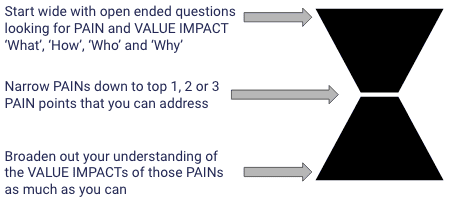- Coaches (3)
- Courses (25)
- Customer Success (10)
- Investment & Fundraising (6)
- Management & Leadership (34)
- Marketing (6)
- Prospecting (19)
- Sales (34)
- Sales Impact Academy News (23)
- Wellbeing (9)
Perfect Your Discovery Process to Supercharge Sales Productivity

- Prospecting, Sales
- Ben Wright
- Estimated Reading Time: 20 minutes
Discovery is often an under-used part of the sales process in many early stage sales teams, and this can cause a lot of problems further down the line in the sales cycle. When deals fail to gain traction, or stall later in the sales cycle, it can often be traced back to not doing deep enough discovery to understand the real pain and the value impact of that pain across the organisation.
As a result, you end up without a strong and compelling value proposition to sell to your Champion and, just as importantly, for them to sell into their own organisation and to the Economic Buyer. In fact, not having this compelling value proposition may even prevent you from finding a Champion within your prospect’s business in the first place, which could kill your deal before it even gets off the ground.
Poor discovery also leads to a lack of understanding of the buying process and the key stakeholders you need to engage with to get a deal across the line, and this too can kill a lot of deals later in the sales cycle.
There are FOUR key things you need to understand about your prospect:
- What is the high-priority PAIN they have that you can take away?
- What is the COST of that pain to the business (i.e. what is the COST of the status quo?)
- How much VALUE can you create by taking this pain away?
- What’s the BUYING PROCESS within the organisation, what other stakeholders need to be involved?
With this knowledge, you can build and maintain momentum in your deals while also establishing trust with prospects. Without it you won’t be able to create a personalized and compelling value proposition to sell to your Champion and won’t fully comprehend the buying process and the key stakeholders you need to engage with to close a deal.
Creating a Discovery Mindset
Let’s start start with an analogy…
Imagine you’re not feeling well and book an appointment with your doctor. As soon as you walk into the room they start talking AT you.
“Wow, you look really sick! Since I’m a doctor, I have lots of experience and have treated people who have looked sick like you before. I recommend you take this medication that has worked on everyone else for the next week and see what happens.”
How would you feel after an experience like this? Would you feel like your doctor really understood your needs? Would you trust them to prescribe the correct medicine having not asked you about your symptoms at all? Would you take that medicine?
Unfortunately, this is exactly what a lot of sales people do. They walk in, tell their prospects how sick they are and then prescribe the solution they’re selling without really understanding anything about what the prospect wants and needs. And their prospects have exactly the same reaction as you probably did to the scenario above.
The interest you show in your prospect’s needs, the expertise you demonstrate through the quality of your questions, and your genuine empathy with your prospect’s situation, will allow you to gain trust. Approach discovery like a good sales doctor, asking them in-depth questions about their problems and the impact of those problems. Only then testing, diagnosing and providing solutions specific to their pains.
How to Structure your Discovery Process
Discovery should take place throughout your sales process, but there are two main points in the funnel which should be dedicated to discovery.

The first is before your initial pitch meeting or demo with your customer. Set up a Discovery Call in order to determine what specific problems the prospect is hoping to solve. This should happen after Qualification to ensure you’re not wasting resources on leads who don’t really fit your ICP.
(If you have a low-cost, transactional product it’s possible to combine qualification with discovery. However, generally with advanced SaaS solutions, qualification calls aren’t long enough to do the in-depth discovery that’s needed).
It is important to book a 20–30 minute discovery call to take place before the demo meeting. However, you should only discuss booking in the call after you’ve confirmed the date and time of the demo. Position the call as part of your standard process and emphasise how it will add value for the prospect. Sales professionals in early stage companies sometimes worry about asking for this time from prospects, but you should have no trouble getting a call booked in if you frame it in the right way.
The second place where discovery happens is during your Demo Meeting where you’ll want to spend around 15 minutes doing deeper discovery. At this point, you’ll recap the information you learned from the discovery call to remind everyone in the room of the key pains and value impact, as well as making sure you didn’t miss or misunderstand anything in the discovery call. If there were any areas of discovery you weren’t able to cover in your discovery call, you’ll want to ask questions about these now. There may also be new stakeholders in the meeting who will need to be brought up to speed and they may be prompted to add pain points of their own which you can then use to frame your proposal.
Booking Discovery Calls
Discovery calls are a really important part of your sales process. They set the trajectory of your engagement with your prospect and will help you to establish a consultative relationship with your buyer.
- An initial discovery call should always happen two to three days before a meeting — It should only take 20–30 minutes.
- Book this call at the same time that you book a meeting and explain it is part of your standard process. A key part of this process is to get the demo meeting date and time confirmed first, and then book in your discovery call then. (Having to follow up with a prospect in order to book a discovery call can waste time.)
- Let the prospect know that the discovery call enables you to personalize the deck and demo which will be a better use of their time.
- Aim to do discovery calls at least 95% of the time; this process only works to improve the conversion rate at stages throughout your funnel if you’re consistent. If you have a strong pipeline, you may even want to think about whether to continue with a prospect who isn’t willing to do that discovery call. Ask yourself whether they’re serious about solving their problems?
How to do Discovery – Sales Impact Academy’s Hourglass Methodology
When you’re running a Discovery Call, or any sort of Discovery process, the end goal is to find somewhere between one and three significant pains that your solution is able to take away that are a high priority for your prospect to fix. High priority at the individual level for your Champion, but also at the Economic Buyer level where your budget is going to be finally signed off, as well as for any other Stakeholders.
It’s important to remember at this point that you need to identify high priority pains. The CEO of a company I worked with once told me that if she’s approached about anything that’s not on her top three list of things she cares about right then, she’s very unlikely to give it much time.
At Sales Impact Academy we teach an hourglass methodology for uncovering these pains and value impacts.

As you can see in the diagram above, the first part is to go wide, asking open-ended questions about challenges, roadblocks and problems that relate to the area in which your solution works. You’re fishing for as many pains as possible at this point, trying to identify problems that need solving. You should be using questions that start with WHAT, HOW, WHO and WHY.
Sometimes it can take a bit of teasing out to get these challenges out into the open. Being genuinely curious is important at this stage, you’re really, really not trying to sell them anything. Approach this part of the conversation as someone who is purely and simply interested in understanding how things work today.
Occasionally when you ask about pains, you can get a barrage of problems, and end up with too many to deal with. Your job here is to try and narrow it down to the really painful TOP THREE problems. You can ask simple questions such as ‘How would you prioritise these,’ or ‘If you could only fix two or three of these, which ones would they be.’
However you do it, once you’ve gone as wide as you can, you need to then start to narrow it down to the key pains that you want to address in more detail. One pain is enough — if that problem is big enough and has enough value impact to your Champion and Economic Buyer that can often be enough to get a deal done. Often, you won’t know enough about the Value Impact at this point, and you may need to identify two or three key pains that you can explore further to understand which is most impactful.
So you’ve gone wide to understand as many pains as you can and then you’ve narrowed it down to the ONE to THREE HIGH PRIORITY PAIN.
Now it’s time to widen out your understanding of the Value Impact of those specific pains you’ve identified. Here you’re trying to understand as much as you can about how these impact the business — either through direct costs or revenue impacts to the business or impacts on individual, departmental or company KPIs. It’s important to go as deep as you can with these PAINs. Keep asking ‘so what?’ types of questions — ‘What does that mean to you, to the business?’ ‘What is the impact of that?’ ‘How does that affect…?’ ‘Who else does this impact?’
Always bear in mind that you need to broaden the discussion beyond just the individual needs for your Champion and understand the broader pains and value impacts for the rest of the buying chain and how much value would be created for them as well.
Preparation
It’s important to decide what questions to ask before the call to set yourself up for success. Many sales reps lose the opportunity to learn valuable information about their customers by asking basic questions before rushing into a sales pitch. Think about your value proposition and what metrics and data points you need in order to establish your ROI.
Ask open-ended questions about business or industry challenges that relate to your solution. You need to gather as many pains as possible so you can identify the significant pains later. If you find you’re not getting the information you need, try stepping back from that line of questioning and ask in a different or nuanced way.
Bear in mind the questions you ask will depend on the type of solution product you offer and who your ICP is. They may also vary depending on the size of the deal you’re pursuing. Larger deals usually require more discovery, and if you have a very high spec tech product, you may need to find out more about their ops process and ask detailed technical questions.
Key Discovery Call Tips:
- Start with the easy questions to get the conversation moving. A great way to start is by recapping any information that’s been passed on to you by the SDR.
- Be genuinely curious, really take an interest in understanding your prospect’s world.
- Find out if there are other stakeholders who have buying power which need to be at the demo meeting. Sometimes prospects won’t want to invite their boss at this point, but just asking the question gives the prospect a psychological nudge, hinting that they will need to involve senior stakeholders at some point in the process.
- You can give your prospect two or three things to do before you meet next. This may be to find out more information which you need for your value proposition.
- Map out the questions you want to ask before your discovery call. It’s a great idea to have a template discovery document which lists all the information your sales reps need to gather.
This is an example of a Discovery Template we provide at Sales Impact Academy DOCUMENT HERE.
If you don’t have a Discovery Template in place today, you should create one for yourself, but also work with your Sales Manager to implement one that works for the whole team.
Monetizing the Pain
As you get towards the end of the call, broadening out your understanding of the one, two or three high priority pains you’ve identified, you’ll want to start understanding the Value Impact of those pains to the business, ideally in monetary terms.
The exact nature of the questions you’ll want to ask will obviously depend on the specific Pain you’re selling to and the associated Value Impact to the business. But whatever that is, you have to try and go as deep as you can in the time you have available.
To take a simple example, it’s not enough for a prospect to tell you that one of the PAINs they’re looking to solve currently takes a lot of manual resources. That’s a great starting point of the conversation, but by no means the end. In this case, you’d need to follow-up with more in-depth questions.
You’d need to ask your prospects questions such as:
How much time do you think is being wasted?
How many people are involved in that process?
What percentage of their time is taken up by this particular process that we’re looking to automate?
What other things could these people be doing if they weren’t spending time on this manual task?
What sorts of things aren’t being done for the business because of this manual task?
How does that impact their ability to hit their own and their department’s key targets?
You may know, or be able to estimate, the average salary of people in this particular job role, and with this information you could make a rough calculation of the commercial impact of this pain.
This level of detail will completely transform the way that you sell because you’ll understand the pain that prospects have at an individual, departmental, and company level. Plus, you’ll know the value impact you can create for everyone in the buying chain.
You should take the time after the call to tailor your deck and demo around these high-impact pains and value impacts. Spending time focusing on their problems — rather than immediately going to your solution — will help you to build an emotional resonance in the meeting with your prospect and build much greater trust. Gone are the days of high level show-up-and-throw-up meetings! This due diligence ensures your proposals are highly personalised to your prospects specific pain.
Discovery in Meetings
It’s a good idea to set an agenda for your sales meeting and send this to your prospect prior to the meeting.
At Sales Impact Academy we teach a three phase 15–20–15 meeting structure. Phase one is fifteen minutes of Deeper Discovery, phase two is twenty minutes for your Deck and Demo, and phase three is fifteen minutes to focus on understanding the prospect’s typical buying process and mapping out next steps.
You may notice that these three phases make up fifty minutes. This gives you leeway for introductions (and the distribution of coffee if you’re meeting in person), people running late or the inevitable tech issues.
In the first 15 minutes meeting phase on Deeper Discovery you need to recap the discovery that you’ve already done, summarising the pains and value impact that you uncovered in the discovery call.
There are three reasons for this:
- You want the pains fresh in everyone’s minds for it to have maximum impact.
- Your prospect may have thought of things since your discovery call that they may want to address. You may also have some questions in order to clarify your understanding or follow up on any data you asked the prospect to bring.
- There are likely to be new people in the room. A key mistake that sales representatives often make is to assume that everyone has the same problem and the same perspective on that problem. You need to understand the broader impact.
During this Deeper Discovery phase of your meeting, you’ll also want to investigate further any areas you didn’t have time for in the discovery call. Hopefully you’ll have a good understanding of the pains from the call, but you’ll almost certainly have follow-up questions about the value impact for these pains, either for the Champion themselves or for other stakeholders you’ve identified during your discovery process.
It’s also worth bearing in mind that your meeting phases don’t have to run sequentially. For example, you may decide to do ten minutes of deeper discovery at the start of the meeting and then pause on one of your slides in the deck (perhaps where you show a summary of your understanding of the value impact of their pain) to ask some more discovery questions.
If you’re interested in learning more about Deeper Discovery and how to run your meetings more effectively, we have four classes on Running Effective Meetings in our 6-week Managing The Complete Sales Cycle course at Sales Impact Academy.



